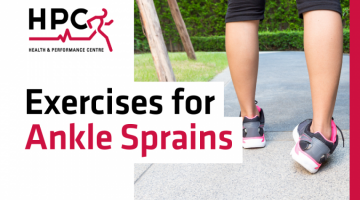Effective Shoulder Exercises for Mobility and Pain Relief

If you're struggling with shoulder pain, limited mobility, or a shoulder injury, physiotherapy can be a game-changer. At the Health and Performance Centre (HPC), located in the heart of the University of Guelph campus, our team of skilled physiotherapists specializes in high-performance injury recovery, prevention, and collaborative care.
In this article, we'll share valuable insights and effective shoulder exercises to help you improve shoulder mobility and tips to help alleviate pain.
Understanding Shoulder Anatomy and Mobility:
To effectively address shoulder issues, it's essential to understand the complexity of the shoulder anatomy and its crucial role in mobility. The Health and Performance Centre's physiotherapists have extensive knowledge of the shoulder girdle, consisting of the clavicle, scapula, and humerus bones. We specialize in assessing and treating shoulder injuries, including those affecting the four important joints: glenohumeral, scapulothoracic, sternoclavicular, and acromioclavicular. Our expertise also encompasses the vital rotator cuff muscles (subscapularis, supraspinatus, infraspinatus, and teres minor) and the visible deltoid muscles (anterior, lateral, and posterior). By addressing these key components, our Guelph physiotherapists develop personalized treatment plans to restore shoulder mobility and strength.
Shoulder Mobility Exercises for Improved Function:
Our team of physiotherapists has curated a set of effective shoulder exercises to enhance mobility and alleviate pain. From pull-downs and around-the-worlds to dislocates and assisted external rotations, these exercises target specific muscle groups and joints involved in shoulder function. By following our expert instructions, you can safely and gradually improve your shoulder mobility, promoting a healthier and more active lifestyle.
You can perform the exercises with a wooden pole as demonstrated in our video or you can use a strap, band of even cable attachments at the gym.
Pull-Downs:
- Hold a wooden pole with an overhand grip, slightly wider than shoulder-width apart.
- Start with the pole overhead, arms extended and elbows straight.
- Slowly pull the pole down towards your sides while maintaining straight arms and engaging your shoulder muscles.
- Feel the stretch in your shoulders as you lower the pole.
- Return to the starting position with control and repeat for the desired number of repetitions.
Around-the-Worlds:
- Hold the wooden pole in front of your body with both hands, palms facing down.
- Keeping your arms straight, slowly raise the pole up and overhead in a circular motion.
- Continue the circular motion until you bring the pole back to the starting position.
- Perform the exercise in both clockwise and counterclockwise directions to target different muscle groups involved in shoulder mobility.
Dislocates:
- Hold the wooden pole with both hands, wider than shoulder-width apart.
- Begin with your arms extended in front of you, then slowly raise the pole overhead and behind you.
- Continue to move the pole behind your body until you feel a comfortable stretch in your shoulders.
- Reverse the motion by bringing the pole back to the starting position in front of your body.
- Repeat the exercise for several repetitions, focusing on maintaining proper form and control throughout.
Assisted External Rotations:
- Hold the wooden pole horizontally with both hands, gripping it slightly wider than shoulder-width apart.
- Stand with your side facing a sturdy anchor point, such as a wall or a pole secured to the ground.
- Keep your elbow tucked into your side and forearm parallel to the floor.
- Slowly rotate the pole away from your body, maintaining a stable elbow and keeping it close to your side.
- Return to the starting position with control and repeat for the desired number of repetitions.
- Perform the exercise on both sides to maintain balanced shoulder mobility.
Remember, it's important to consult with a qualified physiotherapist or healthcare professional before starting any new exercise program, especially if you have any pre-existing shoulder conditions or injuries. They can provide individualized guidance and ensure these exercises are appropriate for your specific needs.
Fixing Posture While Seated at a Desk to Prevent Shoulder Pain
Do you spend long hours sitting at a desk? Poor posture can contribute to shoulder pain and discomfort. Our physiotherapy experts provide valuable tips on correcting your seated posture and optimizing desk ergonomics. By maintaining proper foot placement, adjusting chair positioning, aligning your elbows, and keeping your shoulders relaxed yet engaged, you can alleviate strain on your shoulders and improve overall comfort while working.Here are some tips for improving your posture while sitting at a desk on a computer.
- Keep your feet flat on the floor
- Keep your hips towards the back of your chair
- Keep your elbows close to your body and your forearms, wrists, and hands straight in front of you
- Make sure your shoulders are relaxed but not rounded
Ready to take the next step towards improved shoulder mobility and overall well-being? Book an appointment with our dedicated team at the Health and Performance Centre today. Call us to schedule your consultation. Let us help you move, perform, and live at your best!
Book an Appointment
Related Articles:



